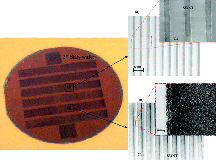| Jaber-Ansari and colleagues characterize the role of surface properties for the assembly and control of SWNT architectures providing a potential basis for wafer-scale manufacturing of SWNTs for a range of emerging devices, systems, and applications. |
Reviewed by Jeff Morse, Ph.D., National Nanomanufacturing Network
Carbon nanotubes (CNTs) continue to be investigated for application in a range of devices due to their unique properties: high electron mobility, unique one-dimensional nanostructure, large current-carrying ability, and mechanical characteristics. In order to capitalize on these properties for defined devices and applications, a simple, reliable, and scalable nanomanufacturing process is required to controllably assemble CNTs with precision placement and alignment over large areas.
Chemical vapor deposition with pre-patterned catalysts, patterned chemical surface functionalization, electrophoretic deposition, and dielectrophoresis all have been explored as methods for directed CNT assembly.While each of these techniques has merit, typical drawbacks include process compatibility, complex chemistries, and limited scalability. Recently, researchers from Ahmed Busnaina’s group at Northeastern University (Xiong et al. 2007) describe the liquid-phase fabrication of highly organized single wall nanotube (SWNT) networks. This method uses lithographically patterned templates and a dip coating process to directly assemble SWNT onto exposed hydrophilic surfaces with varying geometries and feature sizes. While this method offers a scalable level of control to construct complex SWNT architectures for such applications as active elements in transistors, electrical interconnects or sensors, further understanding of the mechanisms surrounding the site-selective assembly for the SWNTs and related scaling issues is required.

The results indicate that the plasma pretreatment of the substrate and the subsequent dip-coating process effectively functionalized the silicon or silicon dioxide surface with hydrophilic chemical groups. Additionally, the plasma pretreatment created nanometer-scale roughness on the surface that increased the density of hydroxyl functional complexes, further enhancing the hydrophilic properties. The authors conclude that the combination of these physical and chemical enhancements provide the means to control the fluidic assembly process, and build highly organized SWNT architectures at large scales. By providing key insight into the underlying mechanisms for the SWNT fluidic assembly process, this study provides the potential basis for wafer-scale manufacturing of SWNTs for a range of emerging devices, systems, and applications.
Also cited
Image reproduced with permission from Jaber-Ansari, L, Hahm, MG, Somu, S, Sanz, YE, Busnaina, A, and Jung, YJ. 2009. Mechanism of Very Large Scale Assembly of SWNTs in Template Guided Fluidic Assembly Processes. J Am Chem Soc 131(2):804-808. Copyright 2009 American Chemical Society.
This work is licensed under a Creative Commons Attribution-NonCommercial-NoDerivs 3.0 Unported.
